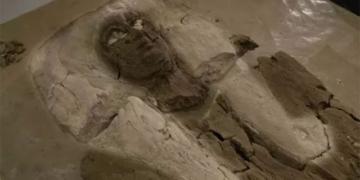To decode the mysteries of Antarctica – the most challenging region on our planet – extensive international cooperation is required.
The ice in Antarctica contains the largest freshwater reservoirs on our planet, accounting for about 70% of the world’s freshwater, and is currently losing ice, contributing to rising sea levels.
In line with the overall trend of global warming, Antarctica is considered the “last pristine land on Earth.” Over 80 scientists from around the world have submitted the most comprehensive study on ice loss in Antarctica ever conducted through satellite data analysis.
The study revealed that over 25 years, from 1992 to 2017, Antarctica lost a total of 3,000 billion tons of ice, leading to a global sea level rise of 7.6 mm! While this figure may seem small and easily overlooked, what worries scientists is that the ice sheet in Antarctica has been rapidly diminishing over the past 25 years, and the rate of ice loss could accelerate amid increasingly complex global warming.
Antarctica is a frigid, snow-covered region with minimum temperatures reaching minus 80 degrees Celsius, making it the coldest place on Earth. The geological activity beneath Antarctica is considered quiet, with ancient, cold rocks resembling the fossils of dinosaurs, remaining unchanged for millions of years.
However, everything changed following a discovery by the British Antarctic Survey.
Surprising Discoveries Beneath Antarctic Ice
Using radar to observe through the 3,000-meter-thick ice, the research team found that some ice masses – covering an area twice the size of London – appeared to be missing.
Upon noticing that the base of the Antarctic ice sheet was melting unusually fast, scientists questioned and found the answer:
Surprisingly, an unusual “hotspot” has been discovered beneath the East Antarctic ice. Its extremely high temperatures have melted an area of 5,000 square kilometers, directly leading to the expansion and sagging of the ice sheet.
Specifically, a 2018 survey by the British Antarctic Survey found that a giant “reactor” twice the size of London lies beneath the solid rock of the East Antarctic ice, melting the Antarctic ice sheet from below, as reported on their website.
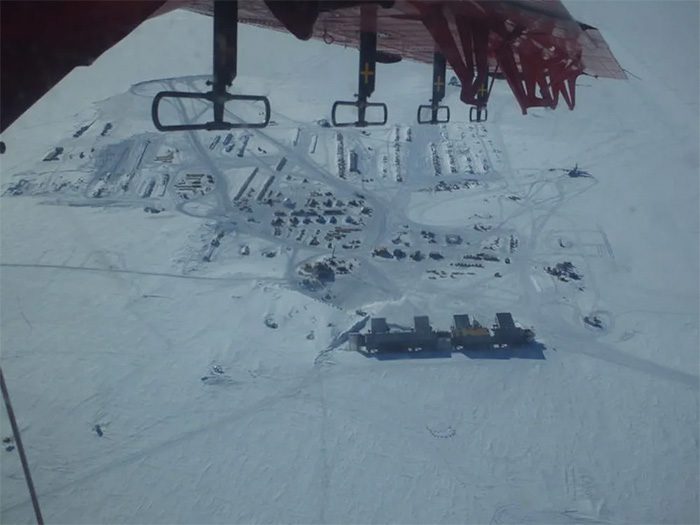
British Antarctic Survey’s Twin Otter aircraft flying over the Antarctic Station. (Source: Dr. Tom Jordan/BAS)
“The melting process we observe has likely been occurring for thousands or even millions of years and does not directly contribute to the ice sheet changes. However, in the future, the excess water in the ice layer could make this area more sensitive to external factors such as climate change,” said the lead author, Dr. Tom Jordan, a geophysicist from the British Antarctic Survey (BAS).
The scientist warns that this “reactor” not only causes glaciers to melt, resulting in rising sea levels (which could have dire consequences for coastal cities) but may also lead to the collapse of snow-covered mountains, posing numerous potential disasters for adventure seekers in Antarctica; ultimately impacting the Earth’s climate.
The research gathered data using BAS aircraft as part of the PolarGAP project. This international project, funded by the European Space Agency (ESA), involves researchers from Norway, Denmark, and the UK, aiming to fill the gaps in satellite data around Antarctica.
Dissecting the “Hotspot”
Duration of Existence
To unravel the mysteries surrounding this giant “reactor,” researchers have embarked on an exploration. However, this is not an easy task; they could only draw some inferential conclusions based on the data available, namely, this hotspot has been present for at least thousands of years.
Formation
The research team believes that this enormous heat source is a combination of unusual radioactive rocks from the Pre-Cambrian period and hot water from deep underground (from the geothermal cycle system of the faults in that area). Both processes simultaneously affect the formation of the “reactor.”
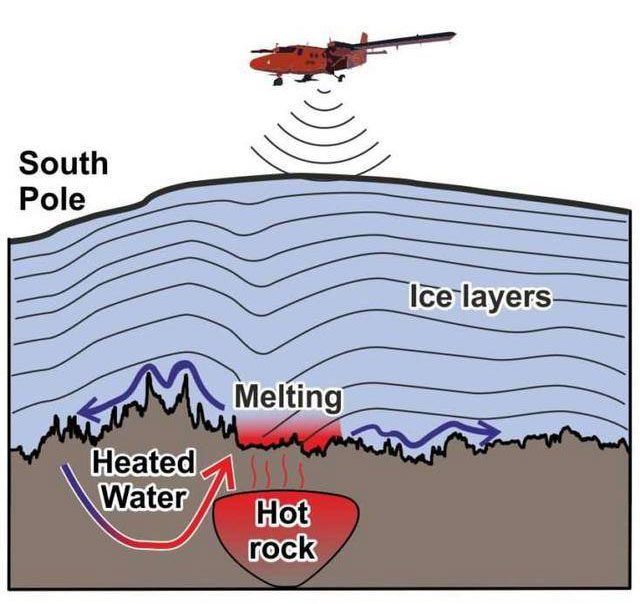
Illustration showing the image of the geothermal hotspot deep beneath Antarctica. (Source: Dr. Tom Jordan/BAS)
Additionally, these findings enhance our understanding of the subglacial hydrology of the Antarctic continent.
This new research explains how an unusually high geothermal amount has melted the base of the ice, leading the upper layers of ice to sag downwards.
“This is a truly exciting project, exploring one of the last completely uncharted areas on our planet. Our results are quite surprising, as many people thought this Antarctic region was composed of ancient, cold rocks, having little effect on the upper ice layer. The discovery shows that even in the interior of this ancient continent, the underlying geology can significantly impact the ice,” Dr. Tom Jordan added.
For a long time, scientists estimated the retreat of glaciers primarily by observing glaciers and ice shelves at the poles from above via satellites. However, today experts know that not only the surface of glaciers is shrinking but also the underwater portions are quietly receding.
Parts of the ice in Antarctica average up to 2,000 meters deep. If these underwater glaciers melt, they pose a real threat. Only a small portion of the glacier is actually above sea level, and the majority is hidden underwater.
The boundary between the floating ice shelf above and the fixed ice below it is called the ground line, which is monitored to determine the magnitude and rate of glacier melting.
Due to the thickness of the ice here exceeding 3,000 meters, researchers could only obtain relevant data about the ice sheet and underlying rock layers by aerially scanning the Antarctic region with ground-penetrating radar.
Mapping Geothermal Activity
After identifying the “reactor” beneath Antarctica, international scientists began mapping geothermal activity at depths of thousands of meters.
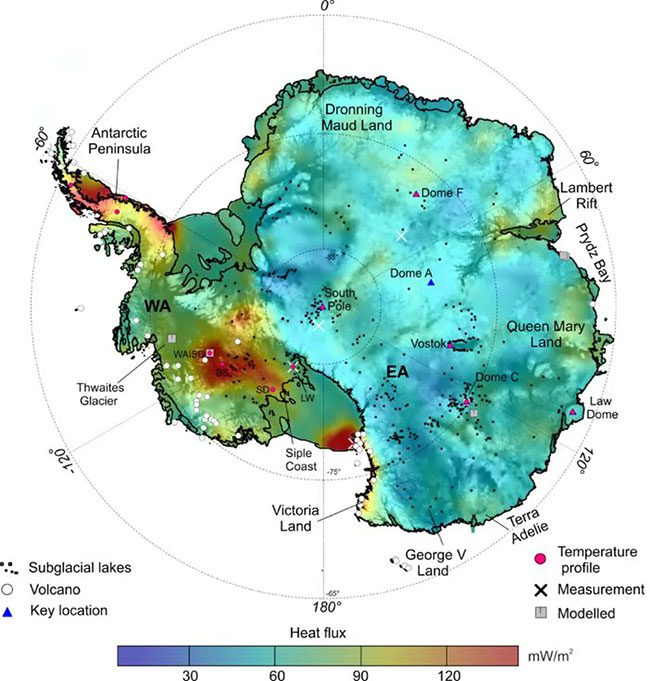
The highest resolution map of geothermal activity beneath the ice in Antarctica. (Source: BAS)
The data used came from magnetic field measurements primarily collected by aircraft flying over the continent, and the results indicate “hotspots” in Antarctica and the Antarctic Peninsula, the fastest-changing areas of the Antarctic Ice Sheet.
This new geothermal map, emerging from within the Earth, will enhance our understanding of conditions at the base of the ice sheet, improving our ability to comprehend the past and predict future changes in the Antarctic ice sheet and its impact on global sea levels, experts involved in the project stated.
Directly measuring heat from beneath the thick ice of 3-4 kilometers in extremely cold and harsh conditions is incredibly challenging. That is why we used magnetic field data to infer the heat, and we are pleased that what we have obtained is 30-50% more accurate than previous studies.
These are groundbreaking preliminary results regarding how international scientists are collaborating to decode the mysteries in the most challenging region on our planet.
Mapping the Glacier Bed in West Antarctica
In addition to studying the ice in East Antarctica, scientists from the British Antarctic Survey are also conducting research in West Antarctica, where the Pine Island Glacier is assessed as the fastest-melting glacier in Antarctica, accounting for approximately 25% of the ice loss in the region.
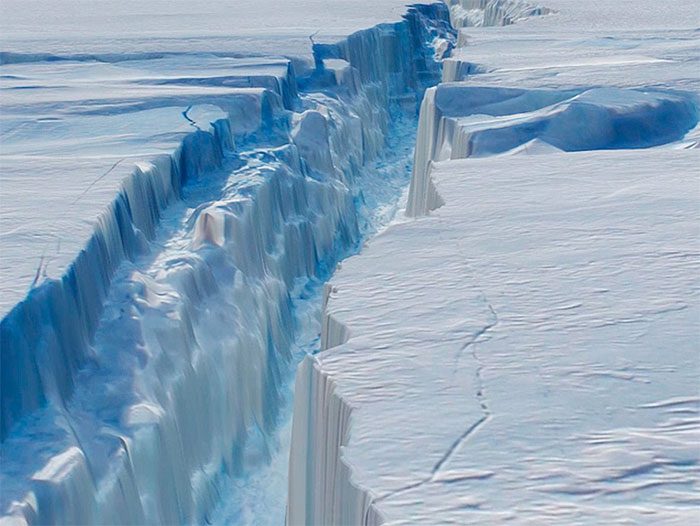
The Pine Island Glacier is regarded as the fastest-melting glacier in Antarctica. (Photo: Internet)
Accordingly, scientists have created high-resolution maps of the Pine Island Glacier’s bed, helping them predict future sea level rises from this area. Radar surveys of the land beneath the Pine Island Glacier revealed a diverse landscape below the ice with several surprises.
This discovery is significant because the Pine Island Glacier is not only melting rapidly but also contributes up to 10% of the global sea level rise from its melting ice. The amount of ice flowing into the ocean in this region is expected to increase as the climate warms and the West Antarctic ice sheet continues to thin.
The study shows that the diverse nature of the terrain beneath the glacier is the biggest factor influencing the flow of ice through the landscape. Scientists will incorporate these new findings into computer models used to predict the future of glaciers.
The Antarctic features a vast network of rivers and lakes beneath its ice, influencing how glaciers move over them. Any modeling of how the Antarctic continent will respond to future warming must consider the subsurface water system.
This discovery is related to drilling for the oldest ice layers on the continent. Scientists are currently searching for evidence that could document the continuous snowfall in Antarctica over 1.5 million years ago.
Antarctica is the largest reservoir of fresh water on Earth. If it were to melt, it could significantly raise global sea levels. For island nations and coastal cities, this poses a real threat.
Therefore, studying and understanding the glaciers in Antarctica is the best approach humanity can take to address one of the frightening scenarios associated with global sea level rise.





















































